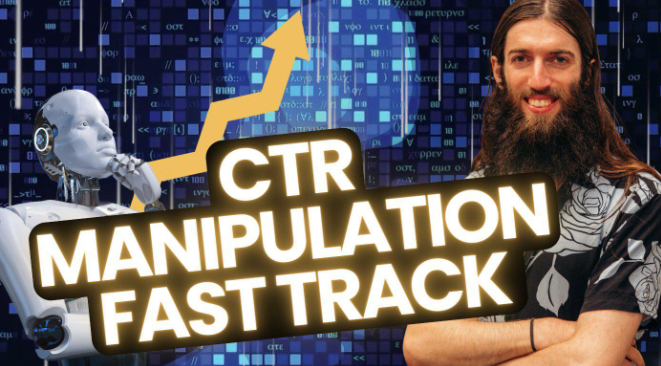Stewart Vickers – CTR Manipulation Course
$47.00 Original price was: $47.00.$18.50Current price is: $18.50.
- Delivery: You Will Receive A Receipt With Download Link Through Email.
- If you need more proof ofcourse, feel free to chat with me!

Sales Page: https://seojesus.com/ctr-manipulation-course/
Delivery Time: Instant DownloadDescription
Table of Contents
ToggleProof of payment:

Stewart Vickers Reveals – CTR Manipulation Secrets Exposed? Stewart Vickers—a name whispered in certain corners of the SEO world, perhaps with a mix of intrigue and apprehension. He’s often associated with unconventional (some might say controversial) approaches to search engine optimization.
Today, we’re diving deep into one particularly fascinating, and potentially risky, area of his purported expertise: CTR manipulation. This article examines the methods, mechanics, and moral quandaries surrounding the practice, particularly as it relates to a “Master CTR Manipulation Course” promising to unlock the secrets of skyrocketing website rankings. Fasten your seatbelts; it’s going to be a click-through rate rollercoaster.
Stewart Vickers
Stewart Vickers, at least in the context of this analysis, is a figure representing a philosophy – a school of thought centered around directly influencing search engine rankings through techniques that some might consider “gaming the system.” Whether a specific individual or a persona embodying a particular SEO strategy, the name stirs debate about the ethics and efficacy of manipulating click-through rates.
The Philosophy Behind the Name
The core idea behind associating Stewart Vickers with CTR manipulation is a belief that user engagement signals, such as clicks and dwell time, are critical ranking factors in search engine algorithms. If you can artificially inflate these metrics, the theory goes, you can trick the search engine into believing your website is more relevant and valuable than it actually is, thereby boosting its position in search results. This inherently challenges the more traditional, “white hat” SEO approaches that emphasize quality content, technical optimization, and genuine user experience.
It suggests a shortcut, a way to bypass the hard work and leapfrog the competition through technical trickery rather than organic growth. This philosophy is rooted in a deep understanding of how search engines might be interpreting user behavior, but it operates on the fringe, pushing the boundaries of what’s acceptable and sustainable in the long run. Think of it as the SEO equivalent of doping in sports – potentially effective in the short term, but carrying significant risks and ethical implications. The appeal is undeniable for those seeking quick wins, but the potential downsides are considerable.
The allure of instant gratification is strong, especially for website owners who have poured their hearts and souls into building online businesses, only to find themselves buried in the depths of search engine results pages. The promise of CTR manipulation, offered under the banner of figures like Stewart Vickers, dangles the prospect of a rapid turnaround, a way to finally see the fruits of their labor. It’s a siren song to those frustrated with the slow, incremental progress of traditional SEO, tempting them with the possibility of overnight success. However, it’s crucial to remember the adage: if it sounds too good to be true, it probably is. The long-term consequences of relying on manipulative tactics can be severe, potentially undermining the very foundation of your online presence.
Ultimately, the philosophy represented by Stewart Vickers is a gamble. It’s a bet that the rewards of manipulating search engine rankings outweigh the risks of detection and punishment. It’s a rejection of the idea that sustainable success is built on genuine value and authentic user engagement, opting instead for a shortcut that may ultimately lead to a dead end. While the promise of rapid results may be tempting, a more prudent approach focuses on building a solid foundation through ethical SEO practices and creating a website that truly serves the needs of its audience.
The Allure of Unconventional SEO Tactics
The charm of unconventional SEO tactics, like CTR manipulation, lies in their potential to disrupt the established order. For years, the conventional wisdom in the SEO world has revolved around content creation, link building, and technical optimization. These are all essential elements, but they require significant time, effort, and resources. Unconventional tactics, on the other hand, offer the tantalizing prospect of achieving similar results with less investment, bypassing the traditional grind and shortcutting the path to the top of the search results.
This is particularly appealing to those with limited budgets or tight deadlines. Startups, small businesses, and individual entrepreneurs often lack the resources to compete with larger, more established players in the SEO game. Unconventional tactics offer them a fighting chance, a way to level the playing field and gain visibility in a competitive market. The promise of a quick win can be incredibly seductive, especially when facing the constant pressure to generate traffic, leads, and sales. However, it’s important to recognize that these shortcuts often come with hidden costs and significant risks. While they may provide a temporary boost in rankings, they can also lead to long-term penalties, including demotions, de-indexing, and even damage to your brand reputation
The allure of unconventional tactics is further amplified by the perception that traditional SEO is becoming increasingly complex and difficult. With Google constantly updating its algorithms, businesses often feel like they’re chasing a moving target, struggling to keep up with the latest changes and best practices. Unconventional tactics offer a sense of control, a way to take matters into your own hands and actively influence the search results, rather than passively waiting for the algorithm to favor your website. This feeling of agency can be empowering, especially for those who feel powerless in the face of Google’s overwhelming dominance.
Ultimately, the allure of unconventional SEO tactics stems from a combination of factors, including the desire for quick results, the frustration with traditional SEO, and the perceived complexity of modern search engine algorithms. While these tactics may offer a temporary advantage, they also carry significant risks and should be approached with caution. A more sustainable approach focuses on building a solid foundation through ethical SEO practices and creating a website that truly serves the needs of its audience.
The Risks and Ethical Considerations
Manipulating CTR, even if it leads to short-term gains, raises some serious ethical questions. Is it fair to mislead search engines into thinking your website is more popular or relevant than it actually is? Are you disadvantaging competitors who are playing by the rules and focusing on creating genuine value for their users? These are questions that every website owner should consider carefully before embarking on a CTR manipulation campaign. Beyond the ethical considerations, there are also significant risks to consider. Google is constantly refining its algorithms to detect and penalize manipulative behavior. If you’re caught artificially inflating your CTR, you could face severe consequences, including a demotion in search rankings, a complete removal from the search index, or even a ban from Google’s advertising platform.
In addition to the risk of penalties, CTR manipulation can also backfire in other ways. If you’re successful in attracting more traffic to your website, but your content is not actually relevant or valuable to those visitors, they’re likely to bounce quickly, sending negative signals to Google that could hurt your rankings in the long run. Furthermore, manipulative tactics can damage your brand reputation. If users discover that you’re trying to game the system, they may lose trust in your brand and take their business elsewhere.
In an era where transparency and authenticity are highly valued, engaging in deceptive practices can be a costly mistake. Before considering any CTR manipulation techniques, it’s essential to weigh the potential risks and ethical considerations against the potential benefits. A more sustainable approach focuses on building a strong online presence through ethical SEO practices, creating high-quality content, and fostering genuine engagement with your audience. This may take more time and effort, but it’s far more likely to lead to long-term success.
Moreover, the focus on quick wins can distract from more fundamental aspects of building a successful online business. Instead of investing time and resources in creating valuable content, improving user experience, and building relationships with customers, website owners may become fixated on manipulating metrics, chasing the next algorithm update, and constantly worrying about being caught.
A sustainable approach focuses on building a solid foundation through ethical SEO practices and creating a website that truly serves the needs of its audience. This may take more time and effort, but it’s far more likely to lead to long-term success.
CTR Manipulation Course
The “Master CTR Manipulation Course,” exemplifies the allure of quick-fix SEO solutions. It promises a shortcut to improved rankings by directly influencing user engagement signals, specifically clicks and dwell time. However, a critical examination reveals the potential risks and ethical concerns associated with this approach.
Unveiling the Course Curriculum
The typical CTR Manipulation Course structure often includes a breakdown of search engine ranking factors, with a heavy emphasis on user engagement metrics. This often includes a review of publicly available (or even leaked) Google documentation to highlight the importance of elements like click-through rate and dwell time. Students are then introduced to the tools and techniques used to artificially inflate these metrics, such as CTRBooster, VPS (Virtual Private Servers), and 4G proxies. The course guides users on how to set up these resources, configure them to simulate clicks from various locations, and monitor the results.
A key element of the curriculum involves understanding how to target specific geographic locations to simulate local search behavior. 4G proxies are emphasized because they allow users to appear as if they are browsing from different mobile devices and locations, making the simulated clicks seem more authentic. The course also likely covers techniques for varying click patterns, dwell times, and other user behaviors to avoid detection by search engine algorithms.
This might involve strategies for randomizing click intervals, scrolling through content in different ways, and even simulating mouse movements to mimic human actions. The promise is that by mastering these techniques, students can trick search engines into believing their websites are more relevant and valuable than they actually are, leading to improved rankings and increased traffic. However, beyond the technical aspects, a good CTR Manipulation Course will also address the risks and ethical considerations, although the degree to which they are emphasized can vary significantly.
A responsible course may discuss the potential penalties for being caught manipulating CTR, as well as the ethical implications of engaging in deceptive practices. It might also offer guidance on how to minimize the risk of detection, although this often involves further refining the manipulative techniques rather than questioning the underlying ethics. Nonetheless, it’s essential for potential students to be aware of the potential downsides before investing in such a course. A more responsible approach focuses on building a strong online presence through ethical SEO practices, creating high-quality content, and fostering genuine engagement with your audience.
The Tools of the Trade: CTRBooster, VPS, and 4G Proxies
For a CTR manipulation campaign, the tools needed typically include: CTRBooster (or similar software): This is the core tool used to automate the click simulation process. It allows users to input keywords, URLs, and other parameters to generate artificial clicks from various locations. VPS (Virtual Private Servers): These are used to host the CTRBooster software and provide the necessary resources to simulate clicks from different IP addresses. They act as virtual machines that can be configured to appear as if they are located in different geographic areas.
4G Proxies: These are used to mask the IP addresses of the VPS servers and make the simulated clicks appear to be coming from different mobile devices and locations. They provide a layer of anonymity and help to avoid detection by search engine algorithms. Setting up these tools can be complex and time-consuming. Users need to configure the VPS servers, install the appropriate software, and configure the 4G proxies to route traffic through different locations.
The process requires a certain level of technical expertise and a willingness to invest time and effort in learning the necessary skills. The costs associated with these tools can also be significant. VPS servers typically cost around $300 and 4G proxies can cost $100 or more per month, depending on the amount of bandwidth required. CTRBooster or similar software also comes with its own fee. Website owners should be aware of these costs before investing in a CTR manipulation campaign.
Beyond the initial investment, there are also ongoing maintenance costs to consider. VPS servers need to be regularly updated and maintained to ensure they are running efficiently and securely. 4G proxies may also need to be replaced periodically to avoid detection by search engine algorithms. Running a CTR manipulation campaign can be a complex and costly undertaking. Website owners should carefully weigh the potential benefits against the risks and costs before deciding to embark on such a campaign. A more sustainable tactic focuses on building a solid foundation through ethical SEO practices and creating a website that truly serves the needs of its audience. This may take more time and effort, but it’s far more likely to lead to long-term success.
The Promises vs. The Reality
CTR Manipulation Courses sell the dream of easy ranking. The promise of improved search engine rankings is the primary motivator for users to enroll in these courses. In exchange for a relatively low price, students are led to believe they can unlock the secrets to skyrocketing their website rankings and gaining a competitive edge over their rivals. The reality of CTR manipulation is far more complex and uncertain. While it is possible to artificially inflate CTR and influence search engine rankings in the short term, the long-term sustainability of this approach is highly questionable.
Google and other search engines are constantly refining their algorithms to detect and penalize manipulative behavior. If caught manipulating CTR, websites could face severe penalties, including demotions in search rankings, complete removal from the search index, or even bans from the platforms’ advertising programs. Another point is that even if manipulative CTR can lead to improved rankings, it does not necessarily translate into increased sales or conversions. If a website’s content is irrelevant or unengaging, visitors may bounce quickly, sending negative signals to search engines.
Furthermore, rankings may be improved, but not sustainable. The benefits of CTR manipulation are often temporary. Search engine algorithms are constantly evolving. Techniques that are effective today may become obsolete or even detrimental in the future. This means website owners need to constantly monitor their campaigns and adapt their tactics to stay ahead of the curve. This type of course selling manipulation tactics are unethical. Artificially inflating CTR goes against search engine guidelines and could be considered unethical. A more sustainable approach focuses on building a solid foundation through ethical SEO practices and creating a website that truly serves the needs of its audience. This may take more time and effort, but it’s far more likely to lead to long-term success.
Seo jesus ctr
“Seo jesus ctr” is an intriguing phrase that likely refers to an individual, an entity, or perhaps even a belief system within the SEO community focused on the click-through rate as a central element of search engine optimization. It hints at a figure who elevates CTR to a near-religious status, perhaps even suggesting that mastering CTR manipulation is the key to unlocking SEO salvation.
The Elevation of CTR to a Ranking Factor
The idea that CTR is a powerful ranking factor is not new. Search engines have consistently emphasized the importance of user experience in determining which websites deserve the top spots in search results. Metrics like CTR, bounce rate, dwell time, and pages per session are all indicators of how well a website meets the needs of its visitors.
This metric focuses on how high you can get. The “Seo Jesus” perspective takes this to an extreme, viewing CTR as the most important ranking factor, above all others. This approach would likely prioritize tactics designed to artificially inflate CTR, even at the expense of other essential elements of SEO, such as content quality, technical perfection, and link popularity.
When it comes to the ranking factors, CTR might be important; but it may not be everything. Viewing CTR as the key ranking factor is problematic for several reasons. First, it is not based on conclusive evidence. While it is true that search engines consider user experience signals, they also take into account many other factors, such as content relevance, website authority, and technical optimization. Second, it is a short-sighted approach. Artificially inflating CTR may provide a temporary boost in rankings, but as discussed earlier, it, more often than not, carries significant risks that can lead to penalties. Third, it is an unethical approach. Manipulating search engine rankings goes against the principle of providing users with the most relevant and valuable results.
The Dangers of a Single-Minded Focus
Focusing solely on CTR, as the “Seo Jesus” approach suggests, can lead to a neglect of other crucial SEO components. If all efforts are channelled into manipulating clicks, essential aspects of SEO, such as high-quality content creation, technical optimization, and link building, might suffer. This neglect can create a weak foundation and make a website prone to ranking loss even if it achieves improved CTR. Focusing solely on CTR can also create a distorted view of how your website is performing. For instance, inflated CTR might mask underlying problems, such as unsatisfactory landing pages or substandard content that will be negatively viewed on website traffic.
A sole focus on CTR also runs the risk of attracting the wrong traffic. Artificial methods may entice visitors who are not truly interested in a website’s services but only click as a result of the manipulated metrics. These visitors will depart quickly, resulting in high bounce rates and little beneficial user experience. This negative conduct shows search engines that the website is not providing a satisfying experience and can harm its long-term ranking potential. The best approach is to create quality content that is genuinely interesting to your target audience and to promote your website utilizing moral SEO practices. This will result in sustainable gains and demonstrate to search engines that your website is both significant and valuable.
SEO is much more than only CTR, so focusing solely on it means disregarding a broader, more successful plan. With quality content, your website will obtain higher ratings and attract real consumers interested in what it has to provide.
Alternative Approaches: Finding Balance
The most sustainable CTR manipulation approach is to create a genuinely valuable website; here are a few alternative approaches of finding that balance: Content Quality: Prioritize the creation of high-quality, relevant, and engaging content that meets the intent of your target audience’s search queries. This will lead to higher organic CTR as users find your website more appealing and informative. A focus on content, over all, is more sustainable.
Technical Optimization: Improve your website’s technical infrastructure, including site speed, mobile friendliness, and crawlability. This will improve the user experience and make it easier for search engines to crawl and index your content. Understanding the Customer Journey: Analyze how your website is doing. Understanding which content works and what can be improved will help you make changes to draw more quality traffic over time which will gradually increase your CTR.
Ethical Link Building: Build high-quality backlinks from reputable websites through content marketing, guest blogging, and relationship building. These backlinks will signal to search engines that your website is trustworthy and authoritative. Focusing on the user experience entails placing genuine value on providing your website’s visitors, and high-quality content, with the best possible experience, not just attempting to trick the systems to your desired position on the search results. Quality, not manipulation, is where your focus should lie.
You should also always be willing to adapt. Instead of putting all of your eggs in one basket, make sure your SEO plan has the flexibility to incorporate changes to algorithms and changing user trends.
Conclusion
While the allure of CTR manipulation, as exemplified by courses and figures like Stewart Vickers and the “Seo Jesus CTR” philosophy, may be tempting, it’s imperative to recognize the inherent risks and ethical considerations. A sustainable SEO strategy prioritizes high-quality content, technical optimization, organic traffic, and user experience. By focusing on these foundational elements, websites can achieve long-term success without resorting to manipulative tactics that could ultimately backfire and harm their online presence. The pursuit of genuine value, not artificial inflation, is the key to lasting success in the ever-evolving world of search engine optimization.
Related products
-
Sale!

[SCAM or Legit] Adam Lucero – Superhuman Discipline System
$497.00Original price was: $497.00.$25.00Current price is: $25.00. -
Sale!

Robby Blanchard Commission Hero AI
$997.00Original price was: $997.00.$39.00Current price is: $39.00. -
Sale!

[GroupBuy] Stefan Georgi – VSL Blueprint Bundle
$297.00Original price was: $297.00.$72.00Current price is: $72.00. -
Sale!

Newsletter Mastery Course Alex Brogan
$997.00Original price was: $997.00.$25.00Current price is: $25.00.

Reviews
There are no reviews yet.